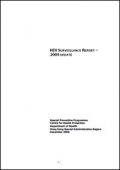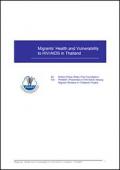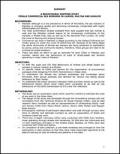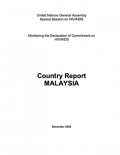What's New
Displaying results 4591 - 4600 of 4914

Resource | Publications,
HIV prevention is a priority in building the new nation of East Timor as articulated by the Prime Minister Dr Mari Alkatiri. The Ministry of Health lead the preparation of this first National Strategic Plan for HIV/AIDS/STI Prevention and Care, 2002-2005 for East Timor. The Plan has been developed through an extensive, twelve-month multi- phase consultation process which included inputs from 139 community stakeholders, twelve district-based focus group discussions involving 221 people, international experts, the United Nations theme groups, international NGOs and bilateral donors.
This Strategic Plan for HIV/AIDS/STI covers a three-year span from 2002 to 2005. It provides the strategic content of the HIV component of the National Development Plan and is consistent with the National Health Policy and Plan of East Timor. The plan is developed in the context of challenges of a post-conflict new nation in its Nation-building phase, which requires extensive capacity building, building of social capital, infrastructure and institution development.

Resource | Publications,
Hong Kong, located in Asia the new burning place of HIV infection, is still having a relatively low prevalence of HIV infection. While sexual transmission is the predominant route of transmission in Hong Kong, an upsurge of infection in injecting drug users is a concern from the experience in other Asian localities. Various public health measures in Hong Kong have kept the HIV prevalence of drug users at low level, as compared with neighbouring cities.

Resource | Guidelines,
The guidelines for the transport sector look at some of the specific problems facing transport – the emphasis is on road transport but consideration is also given to other transport industries. They then present an overview of initiatives that have been taken, first at the legal and policy level then at the workplace, to address the occupational and behavioural risks associated with transport. It incorporates examples of action and guidance based on lessons learnt. It takes the reader through the code of practice and training manual, and shows where transport sector operators and authorities can find relevant provisions, explanations and advice to help them develop and implement HIV/AIDS programmes.

Resource | Publications,
Migrants’ situation in Thailand is precarious. Due to their tenuous legal status and numerous barriers that limit access to health services and legal mechanisms, migrants endure poor working and living conditions without being able to receive full or proper treatment for related health conditions. With a sense of loss of control over their life, and without being able to access health information and services in their own language, migrants’ vulnerability to HIV and other reproductive health conditions increases, as does their susceptibility to contagious diseases and other health problems.
This report reviews the numerous factors that affect migrants’ health in Thailand, exploring work and living conditions, structural barriers to health services, and issues of emotional well-being and human rights. Information is based on informal reporting from the field, which is corroborated by a literature review. The purpose of the report is to show that migrants' health in Thailand is significantly affected by various factors that are out of their control, such as unsanitary work and living conditions and the inability to access health information and services.

Resource | Publications,
Research suggests that youth are consuming more alcohol and at younger ages than in the past. Data also indicate that alcohol consumption is associated with participation in other risk behaviors including aggression and sexual behaviors. As part of a randomized control effectiveness trial for an HIV prevention program, 480 Vietnamese youth (15–20 years old) living in eight rural communes in Khanh Hoa Province were administered a paper and pencil baseline evaluation. The evaluation included items for actual and intended alcohol use, perceptions of peers’ alcohol consumption, and attitudinal questions regarding alcohol. The tool included questions on engagement and intention to engage in sexual behaviors.

Resource | Tools,
Logistics Management Unit is responsible for the management of supplies needed for HIV/AIDS and STD care and treatment in Cambodia. It has established Terms of Reference for its role and responsibilities and Standard Operating Procedures for all its activities.
The Standard Operating Procedures provide a clear outline of the timeframe in which reports/requests must be processed.

Resource | Tools,
Condoms play a special role in combating the spread of HIV/AIDS because they are presently the only devices that protect against sexually transmitted HIV. However, high costs to users, limited availability and accessibility, and negative perceptions of condoms have created a gap between the number of condoms distributed and the amount needed for populations to protect themselves from HIV/STIs. Improved condom programming can help close the gap in condom supply and use, and reduce the spread of HIV. The goal of condom programming is to ensure that sexually active persons at risk of HIV/STIs are motivated to use condoms, have easy access to quality condoms, and can use them consistently and correctly. It addresses the supply of and demand for condoms as well as the political, sociocultural, and economic environment.
This manual outlines a seven-step process to improve the effectiveness of existing condom programmes or to create a new condom programme. It is designed to give managers practical and specific advice on condom programming.

Resource | Publications,
Pakistan although is a low prevalence in terms of HIV/AIDS, the sex industry in Pakistan is changing rapidly and becoming increasingly complicated with highly differentiated sub sectors. The most authoritative studies available from Asia suggest that sex market is vast and the Pakistan market seems to be increasingly contributing to the markets in Middle East, Asia as well as to the demands from London, all under the cover of dancing and singing troupes.

Resource | Publications,
The rise in HIV/AIDS has continued unabated since the first three cases of HIV in Malaysia were diagnosed in 1986. In recent years, the numbers reported have increased at an average rate of about 500 to 600 per month, and more than 7,000 have died. As of December 2004, official reports document 64,439 people with HIV/AIDS in Malaysia (Ministry of Health 2005). Despite efforts in the national response to contain the spread of this infectious disease, the United Nations MDG Report 2005 concluded that Malaysia has achieved commendable successes towards all the MDGs except in halting and reversing the spread of HIV/AIDS (UNDP 2005). There is a serious concern that the HIV/AIDS situation may escalate to a general epidemic in the near future.

Resource | Publications,
India, along with other Member States adopted the Declaration of Commitment on HIV/AIDS, in the United Nations General Assembly Special Session (UNGASS) on HIV/AIDS in June 2001. The Declaration of Commitment reflects global consensus on a comprehensive framework to achieve the Millennium Development Goal of halting and beginning to reverse the HIV/AIDS epidemic by 2015.





